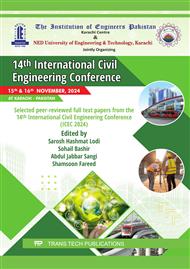p.109
p.117
p.127
p.139
p.149
p.157
p.165
p.173
p.181
Evaluation of Effects of Pounding on RC Building Structures under Strong Seismic Events
Abstract:
During earthquakes, structures move laterally and since usually a proper gap distance between structures is not provided so the structures can collide with each other. Building codes which are commonly used, do not offer any provisions for designing the structures for additional forces due to pounding and so structures are susceptible to damage subjected to pounding during strong seismic events. Therefore, in the current study, effect of pounding on a structure is studied considering different parameters including number of stories, total weight, story stiffness and floor alignment with adjacent structure. Furthermore, to investigate the effect of each parameter in isolation and avoid the effect of speed difference of colliding structures, a similar gap in fundamental periods has been used. It was found that pounding significantly effects the upper stories as compared to lower stories. It was also found that if the floors are aligned, total weight of the adjacent structure is the most critical parameter which severely effects on a structure’s upper stories. It was also observed that if the floors are not aligned, a significant increase in story shear occurs.
Info:
Periodical:
Pages:
149-156
Citation:
Online since:
April 2025
Authors:
Price:
Сopyright:
© 2025 Trans Tech Publications Ltd. All Rights Reserved
Share:
Citation:


